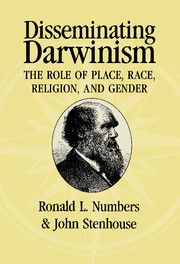Book contents
- Frontmatter
- Contents
- List of contributors
- Acknowledgments
- Introduction
- 1 Science, region, and religion: the reception of Darwinism in Princeton, Belfast, and Edinburgh
- 2 Darwin down under: science, religion, and evolution in Australia
- 3 Darwinism in New Zealand, 1859–1900
- 4 Environment, culture, and the reception of Darwin in Canada, 1859–1909
- 5 Darwinism in the American South
- 6 Darwinism, American Protestant thinkers, and the puzzle of motivation
- 7 Exposing Darwin's “hidden agenda”: Roman Catholic responses to evolution, 1875–1925
- 8 American Jewish responses to Darwin and evolutionary theory, 1860–1890
- 9 Black responses to Darwinism, 1859–1915
- 10 “The irrepressible woman question”: women's responses to evolutionary ideology
- Index
2 - Darwin down under: science, religion, and evolution in Australia
Published online by Cambridge University Press: 06 July 2010
- Frontmatter
- Contents
- List of contributors
- Acknowledgments
- Introduction
- 1 Science, region, and religion: the reception of Darwinism in Princeton, Belfast, and Edinburgh
- 2 Darwin down under: science, religion, and evolution in Australia
- 3 Darwinism in New Zealand, 1859–1900
- 4 Environment, culture, and the reception of Darwin in Canada, 1859–1909
- 5 Darwinism in the American South
- 6 Darwinism, American Protestant thinkers, and the puzzle of motivation
- 7 Exposing Darwin's “hidden agenda”: Roman Catholic responses to evolution, 1875–1925
- 8 American Jewish responses to Darwin and evolutionary theory, 1860–1890
- 9 Black responses to Darwinism, 1859–1915
- 10 “The irrepressible woman question”: women's responses to evolutionary ideology
- Index
Summary
Darwinism came early to Australia. Charles Darwin's Origin of Species appeared on sale in Sydney only four months after its publication in Britain. Within a year, worried presidents of the local scientific societies were joining forces with church leaders to warn of the social and intellectual dangers of “the development hypothesis,” and various Australian scientists were privately expressing fears about the adverse effects of Darwinism on traditional thinking. Yet within three years of the arrival of Darwin's book, an Australian scholar had pioneered, in the application of Darwinism to political economy, an achievement that elicited approval from no less a person than Herbert Spencer; and within fifteen years Darwin himself was praising an Australian botanist for his contributions to organic evolution. By the last decades of the century, Darwinism had become entrenched in the major teaching institutions of the country, and many churchmen were comfortably accommodating the new science of life to Christian theology.
Assessing the impact of major ideas on any given society is both challenging and frustrating. The very term society slips through the fingers as soon as one attempts to grasp it. Who received new ideas: all the citizens or a select few? In a continent the size of Australia, which for most of the nineteenth century comprised little more than a handful of sparsely populated colonies clinging to the coastal fringe, the difficulties are compounded. Each of the colonies possesses a distinctive history.
- Type
- Chapter
- Information
- Disseminating DarwinismThe Role of Place, Race, Religion, and Gender, pp. 39 - 60Publisher: Cambridge University PressPrint publication year: 1999

